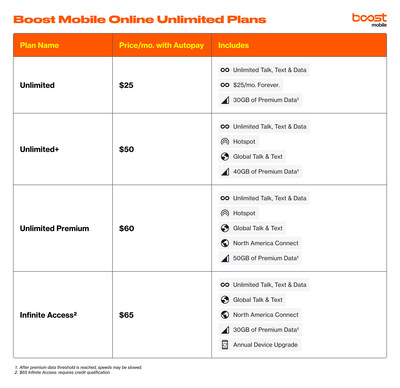Dish parent company EchoStar this month unveiled a plan to revamp Boost Mobile in an effort to turn the company’s wireless fortunes around after the less than successful Boost Infinite postpaid launch in late 2022.
Impact: EchoStar CEO Hamid Akhavan previously alluded to the need to revamp its Boost Mobile service on the company’s Q1 earnings call and vowed to roll out a new Boost sometime in the second half of the year.

While the changes don’t constitute a wholesale revision of Boost Mobile, they represent a significant effort to raise EchoStar’s wireless profile and include a brand update that puts both prepaid and postpaid under the Boost Mobile name, a new advertising campaign highlighting the company’s fledgling 5G network and its coverage to 99% of the country, and updated plan options that include a $25/mo unlimited tier and give customers flexibility and value. The company will also offer a 30-day money-back guarantee that makes it easier for customers to switch and enables them to try Boost Mobile risk-free so that they get a feel for the speed and reliability offered by the EchoStar (Dish) network.
The brand update puts both prepaid and postpaid under the Boost Mobile name to create a “new unified digital experience” that counters what Akhavan called the “complexity” of today’s wireless market. EchoStar claims it’s the only nationwide carrier to offer prepaid and postpaid options under the same brand name, although not every analyst thinks that’s a good strategy. It also includes a new look and logo with an infinity symbol, as well as a nationwide brand campaign that aims to position Boost Mobile as the best mobile option for customers focused on value in their wireless service, without the hidden fees that increase the price. Four new pricing plans start at $25/mo for the first line of service and represent more choice for customers, with the top-level plan priced at $65/mo. Customers get unlimited talk, text, and data service that includes 30 GB of premium data, a forever price lock for new customers who sign up with auto pay, and a 30-day money-back guarantee that enables them to try Boost Mobile risk-free. They can also add-on services, including international options and device protection, as needed.
EchoStar designed the plans to appeal to postpaid subscribers, which bring in more revenue than prepaid customers. Because if there’s any company in the wireless business that needs to ramp up its revenue as quickly as possible, it’s EchoStar after taking on Dish’s nightmare financial situation when the two companies re-merged at the end of last year. EchoStar has also been moving more customers away from the AT&T and T-Mobile MVNO networks and onto its own 5G network to cut costs and generate higher per-customer margins. As of May 2024 when EchoStar held its Q1 2024 earnings call, the company claimed 7.3 million wireless subscribers with three of five new Boost Mobile users running on its 5G network.
But as LightReading points out, that still leaves a lot – and possibly even a majority – of Boost customers sitting on the AT&T and T-Mobile networks. In talking about the EchoStar network and Dish as a wireless carrier in general, Boost Mobile executive Sean Lee emphasized the newness of the network. He also called the company the “boldest” carrier and indicated it wants to change the wireless industry from the inside, starting by focusing on being a “digital-first organization.” But until EchoStar can move more of its subscribers onto its own network and position Boost Mobile as a carrier option in Apple and Samsung stores and on their websites, the company will likely struggle to establish itself as a viable competitive option versus larger U.S. carriers that dominate the national wireless market. Although EchoStar appears ready to plot its own course as a wireless carrier, there’s no guarantee this revamp will work or that the company will be able to overcome enough myriad issues to avoid bankruptcy.
